All over the world, teachers are quitting in droves. And they’re not silent about what’s causing this mass exodus.
Stress.
Teacher stress is at epidemic levels, and it’s having a major, negative impact on education worldwide.

Image source
Teacher stress is a well-discussed topic both on this site and elsewhere, so we won’t linger on its causes. Let’s just say that a lot of things need to change – and change fundamentally – in order to address the problem.
Some changes (the pressure to meet increasingly unattainable targets, for example) need to come at the government level. Others (e.g. tricky relationships between teachers and families) need to come at the family/societal level.
Other changes, however, can be implemented at school level. These changes include taking advantage of new edutech designed to ease teacher workload and take the pressure off school staff in general.
Educational automations are among the most exciting of these technological solutions. Right now, companies with agile manifesto values are working hard to bring teachers the intuitive, flexible, and time-saving automations they need.
If implemented and managed well, automated edutech could take a huge load of work from teachers’ shoulders. It could give teachers a huge amount of admin time back. Time that they can use to de-stress, get ahead with prep, and to do what they do best – teach.
Here, we’ll take a look at the ways in which educational automation could help to make teacher stress a thing of the past:
1. Automated record-keeping
Modern teachers have to do an enormous amount of record-keeping. From basic registers to things like compliance and reporting, record-keeping forms a substantial part of the admin burden on teachers. This is a huge workload which, many teachers believe, takes them away from more important tasks.
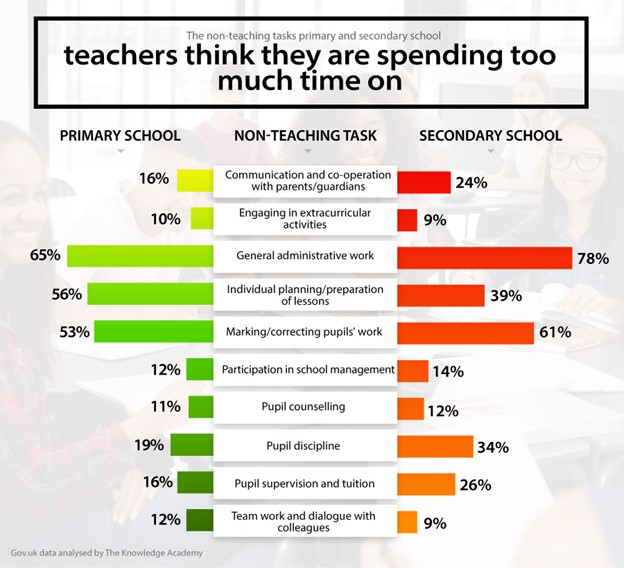
Image source
So, how can tech help with record-keeping?
Well, tracking tech is particularly useful here. For example, platforms like Zapier and Kinteract offer progress-tracking software. This records things like grades, achievements, and even behavioral milestones.
The software can track these factors over time and deliver intensely personalized reports on individual students, with analysis, actionable insights, and even recommendations for educational pathways.
Teachers can update these records with a few clicks, and leave the automation to do the rest. This saves a massive amount of time both entering data into records and combing through it for insights.
Then there’s student enrollment and attendance. Platforms like Trello can easily create a card at enrollment for every single student. This can then be synced with automated registers with the help of hybrid cloud integration, ensuring that no student gets lost in the system.
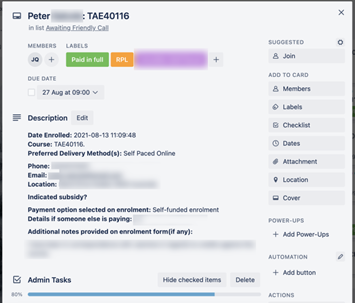
Image source
If, at any point, these various automated records don’t match up or show a consistently troubling pattern, the relevant person (a tutor, for example, or the school counselor, or the head teacher) can be automatically alerted.
The most common objection to automated record-keeping is that these records are very important. They’re vital for keeping students safe, keeping staff accountable, and more.
It’s a good and very valid objection, but it’s based on an inaccurate assumption: that automations cannot (or will not) keep records as accurately and diligently as humans can.
In fact, the opposite is true. So long as they’re set up properly in the first place, automations are far more consistent than human record-keepers. They don’t ever drop the ball when they’re tired. They can’t be fooled by student tricks. And they don’t take breaks.
Plus, if educators are ever concerned about how well their record-keeping automations are performing, they can take advantage of the many on demand testing services out there. These will put the system through its paces, and make sure that it’s working properly.
So, not only can record-keeping automations take a load of work from teacher shoulders, they can also perform mundane functions far more accurately, consistently, and efficiently than their human counterparts ever could.
2. Planning, lesson prep, and other workflows

Image source
Teaching is hard work. We all know that. But a lot of teaching’s most time-consuming tasks are mundane, workflow-related tasks that could easily be done by automations.
Automating workflows could give teachers a lot more breathing space (and massively reduce the paper footprint of a school to boot!)
For example, by creating a set of versatile, easy-to-use templates and uploading them to a central resource bank like that offered by Hoylu, teachers can save a huge amount of time on things like lesson planning and worksheet creation.
Similarly, when curriculums and school day tasks are laid out on a workflow-planning app like Asana or Trello, they become easy to see, follow, and modify. Familiar workflows can be copied and reused with just a couple of clicks.
By automating the most repetitive and time-consuming aspects of the day-to-day workflow, teachers can streamline their work and save themselves many hours in the process.

Image created by author
There are plenty of workflow apps out there with a lot of digital applause. Asana, Trello, Slack, and even specialized educational platforms like Kinteract and 360Learning are very well-regarded in the industry. But if teachers are concerned about how well a software solution will perform, they could always undertake some model risk management.
What is model risk management? Well, it involves testing through various models with an eye to the ways in which they can possibly go wrong. In some cases, you may even go in with the explicit aim of ‘breaking’ the model. This will help you to pick the most foolproof model possible.
3. Communication
The pandemic taught millions of schools about the advantages (and disadvantages) of technology.
We discovered which web conferencing software was school-friendly, and which wasn’t. We saw the rapid rise and refinement of many school-specific remote teaching platforms. And, ultimately, we had to acknowledge that we couldn’t have got through 2020/21 without this tech.
But how can automations help with communication in ordinary times?
Well, think of the humble ‘Out Of Office’ email.

Image source
We’ve all received OOO emails. Many of us have even used them from time to time. They’re incredibly useful – they mean we don’t have to check emails while we’re on vacation, and they alert communicants to our absence without causing any frustration.
The OOO email is the classic automated communication. But automated emails are capable of a lot, lot more than this.
By using communication automations to their full potential, we can save teachers a lot of time, and strike a decisive blow in the war against teacher burnout.
Email automations can be triggered for a variety of events and occurrences. For example, rather than compiling reports and giving them to each student to deliver by hand, reports can be automatically emailed to each parent or guardian.
Similarly, parents and guardians can be kept up to date with automated newsletters, or informed immediately if their child is put in detention, performing at an above average level, and so on.
Huge chunks of enrollment journeys can also be automated. Each new student (and/or their parent/guardian) can be sent a series of automated emails taking them through the basics of the institution, what’s expected of them, next steps, vital information, and so on.
Even contractual communications can be automated to some extent. Docusign and Panda Doc alternatives to Docusign have made digital signatures easy and valid. So, now, automations can launch digital contracts safely and efficiently without taking up too much human time.
Automation doesn’t just apply to emails, of course. All communication channels can be automated to some extent. If a communication is regular, formulaic, and triggered by time/events, it can easily be automated.
Further, teachers can reclaim a lot of the time they currently devote to fending off parent/guardian communiques by implementing automations.
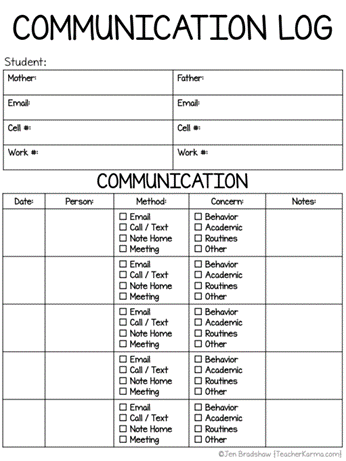
Image source
On one level, being able to communicate directly with teachers is great for building teacher/parent relationships. But, on the other hand, it can be time-consuming and stressful for teachers to deal with parents/guardians in their off hours. It also adds to the burden of classroom management.
By automating Out Of Hours communications on all their channels, teachers could reclaim their ‘me’ time. To make this easier for parents and guardians, teachers could even set up an automated appointments system, whereby parents/guardians book a slot to call, text, email, or meet in person.
With automations like these, everyone gets the communication they need at a time that works for them.
4. Marketing and social media
Schools these days can’t just teach kids and leave it at that. They also have to have a social media presence, and perhaps even market themselves to prospective students and/or their parents/guardians.
While schools may not need to know things like how to find affiliate marketing programs or how to promote their brand to millennials, they could often use some help when it comes to social media and the like.
Sometimes, teachers may be asked to give up more of their precious time to contribute to the school blog, newsletter, or social media. Of course, teachers can create great content and are definitely a valuable resource when it comes to a school’s online presence – but all too often teachers are asked to contribute when the school is struggling for stuff to post.
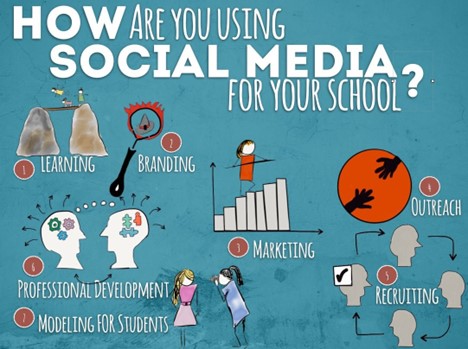
Image source
So, teachers have to give up time they don’t have in order to create what amounts to filler content.
Automations can easily change all that. From scheduling posts to moderating comments, suggesting topics, and even writing rudimentary content, there are a wealth of social media automations out there to make a school’s digital life easier.
With tools like Hootsuite, digital administrators can easily create and schedule posts across a variety of platforms. Automatic analysis and insight functions can be set up, designed to display ongoing metrics and provide detailed breakdowns of what it all means in practical terms.
Tools like SocialPilot give marketers a centralized dashboard from which to view and respond to social media messages across all channels. They can also deliver automated alerts for certain keywords and phrases – handy if a concerned parent or guardian’s message needs to be seen RIGHT NOW and not get lost in the clutter of a school inbox.
Automations can take a lot of the time and trauma out of social media management. This means schools can keep (and even enhance!) the benefits of a social media presence – but not at the expense of their more important work.
Automation – giving schools back to teachers
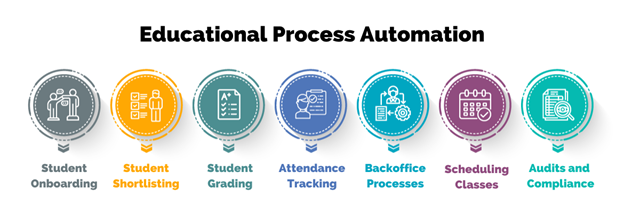
Image source
Teaching has never been an easy job. But it’s now harder than ever before. Teachers all over the world are raising their voices and saying that the workload is just too much.
They’re not complaining about the teaching itself, or even the time it takes to prepare for lessons. They’re complaining about the huge admin burden that increasingly falls on their shoulders. Mundane, repetitive tasks that take up enormous amounts of time. Time that could be better spent focusing on the students themselves.
The thing is that these tasks can’t be cut out. They’re essential for things like safeguarding and progress-tracking. If we want safe, modern, efficient schools in which students are cared for and in which they never fall through the cracks, this kind of admin is important.
However, it doesn’t need to be done by teachers.
Automations can relieve a lot of the admin burden on teachers. By automating frequent, repetitive, and mundane tasks, teachers can retrieve swathes and swathes of their valuable time without sacrificing anything in the process.
So automation certainly benefits teachers. But it also benefits students.
It’s worth mentioning that modern children will graduate into an increasingly automated world. Getting used to interacting with accessible automations and automated systems early on will set them up for success in the future – and could lead to a vital increase in software diversity as more tech-savvy students hit the workforce.
So, for stress-free teachers and tech-literate students, automation in education really is the way forward.
The post Automation as The Key to Ease Teacher’s Workload: What You Need to Know appeared first on Emerging Education Technologies.
------------Read More
By: Emily Rollwitz
Title: Automation as The Key to Ease Teacher’s Workload: What You Need to Know
Sourced From: www.emergingedtech.com/2022/06/automation-key-to-ease-teachers-workload/
Published Date: Mon, 27 Jun 2022 11:02:57 +0000
Did you miss our previous article...
https://trendinginbusiness.business/technology/microsoft-teams-is-storing-authentication-tokens-in-cleartext
.png)





